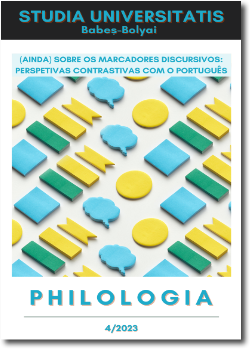O CLARO É CERTO? OS MARCADORES DISCURSIVOS CLARO (PT) E CERTO (ITA): ESTUDO CONTRASTIVO
O CLARO É CERTO? DISCOURSE MARKERS CLARO (PT) AND CERTO (ITA): A CONTRASTIVE STUDY
Author(s): Ana Paula Loureiro, Silvia BrambillaSubject(s): Descriptive linguistics
Published by: Studia Universitatis Babes-Bolyai
Keywords: discourse markers; epistemic discourse markers; dialogue; certo; claro;
Summary/Abstract: O claro é certo? Discourse markers claro (PT) and certo (ITA): a contrastive study. The present study aims to compare the dialogical uses of two discourse markers (DM), namely the European Portuguese claro and the Italian certo, by analysing the data extracted from two corpora of spoken language (the Corpus de Referência do Português Contemporâneo and the KIParla corpus). Both claro and certo are part of the group of conversational markers of epistemic modality, which includes a vast set of linguistic expressions revolving around the semantics of "right", "clear", and "obvious". This study shows that in European Portuguese, claro is the most frequent and polysemic DM (the “pivot form”), playing different functions in the construction of interpersonal cooperation and negotiation of meaning: in dialogical contexts, claro can mark cooperative attention, emphatic response, or agreement. To mark such functions, claro can occur within different syntactic and functional patterns, such as repetitions and co-occurrence with other DMs. In the comparison with Italian, data show that certo functions similarly in a great extent of communicative situations, thus concluding that semantic and functional parallelism can be drawn between the two DMs. However, a noteworthy difference in use relies on the speakers’ choice of DM during their communicative exchanges: in European Portuguese, speakers seem to utter different epistemic DMs in a sequence of dialogical turns to signal the same functions, while it does not appear as natural in Italian. On the contrary, Italian speakers appear to use one epistemic DM at a time. This difference, although subtle, may constitute a critical area for translation.
Journal: Studia Universitatis Babes-Bolyai - Philologia
- Issue Year: 68/2023
- Issue No: 4
- Page Range: 77-98
- Page Count: 22
- Language: Portuguese

